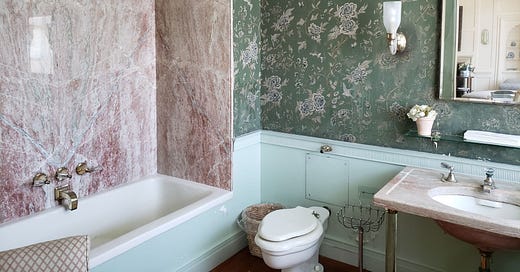Touch Points: Interesting Bathrooms
When You Find Yourself Really Interested in Toilets...
It starts when you talk about toilets and toilet fixtures on tour all the time. It starts when you give a tour that regularly uses the phrase, “the house that toilets built”.
I mean, let’s be fair. It was partially toilets, but it was really pipes and plumbing and U. S. Navy contracts that did it. But the public face of Crane Co. would be, for much of the 20th century, affordable bathroom fixtures.
You cannot have a job at the summer home of the Crane family without walking out and looking at every toilet you sit on for the foreseeable future. And every time you see that bird on the back of the toilet, you know it’s a Crane. And then you walk out of the public bathroom and immediately tell everyone in your group, “Hey! They’ve got Crane toilets!”

Or is this just me?
I now can’t go on tours of other houses without being extremely interested in the plumbing. Is there a maker’s mark? (More often than not, no.) Is it a Crane? Is it someone else? Did they have more than hot and cold water taps, such as an ice water or salt water tap? When was the bathroom installed? Does it have a tank? Weirdly, no one has ever asked (when I ask these questions) if I am a plumber. Not that I look like a plumber, but you’d think it would happen at least once.
Even the butler’s pantry has more interest to me than the bedrooms, especially if they have plumbing fixtures that are ahead of their time.
Having moved to New York City, Crane toilet spotting is not an uncommon occurrence. Many of the buildings (including my sister’s apartment) date from the heyday of Crane’s residential and commercial successes. Crane toilets - including the tankless model seen in the above photo - are everywhere in New York City.
Crane Company was established by Richard Teller Crane Sr. on July 4, 1855 in Chicago. “The company had been selling fixtures and trim since 1886, and in 1895 launched a line bearing the Crane name, built (by Kohler and others) to the specifications of the firm’s engineers.” It was Richard Jr, however, who decided to start making fixtures in-house. He bought Trenton Potteries Company in 1920, which was used until 1970. He also established Crane Enamelware Company in Chattanooga, which remained operational until 1973, and enabled Crane to start making enamelware in a variety of colors. On top of that, Crane “embarked on a bold consumer advertising campaign in full color”. A new idea using new technology that clearly paid off given the number of places you can find the Crane name on bathrooms. They even opened a new showroom that was state-of-the-art in Atlantic City.1
The Great House at Castle Hill on the Crane Estate was completed in 1928, so it takes full advantage of the new pottery and enamelware capabilities that the Crane Company had. Every bathroom in the house shows the full luxury that the Crane Company could create - and of course, every room, including the guest rooms, has an en suite bathroom.
Given the longevity of the Crane Company, it’s no wonder that walking into any house built after 1886 that has indoor plumbing would prompt the question, “Who made these toilets?” It is certainly a different spin to take when taking a house tour - and one that most tour guides will likely not know the answer to. But I challenge you not to ask those questions now.
Crane: 150 Years Together. Printed and produced by the Crane Company. 2005. pg 43. https://www.craneco.com/wp-content/uploads/2023/02/crane_150.pdf
Enjoy an interactive timeline of the Crane Company here: Our History - Crane Company



